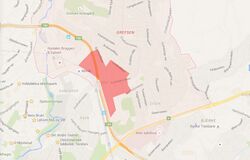LED 2016 Group I Landscape Democracy Challenge 4: Difference between revisions
| Line 56: | Line 56: | ||
== References == | == References == | ||
*Arnstein, Sherry R. "A Ladder of Citizen Participation," JAIP, Vol. 35, No. 4, July 1969, pp. 216-224 | *Arnstein, Sherry R. "A Ladder of Citizen Participation," JAIP, Vol. 35, No. 4, July 1969, pp. 216-224 | ||
*... | *Arkitektur og demokrati, åpenhet og debatt (2016, april 27). Retrieved from https://www.stortinget.no/arkitektur-og-demokrati-apenhet-og-debatt | ||
*... | *... | ||
Revision as of 06:15, 4 July 2016
Grefsen, Oslo: Quiet Desicion Making
| Place name | Grefsen | |
| Location | Oslo | |
| Country | Norway | |
| Author(s) | Kjersti B Skjelbreid | |

| ||
Rationale: Why have you chosen this case for the landscape and democracy seminar?
The municipal sector plan for the area Grefsen, describing the development of Oslo towards 2030, in Oslo approved big changes in the area without the local municipality taking notice of it. A local newspaper wrote about it after it was already decided, which lead to a big conflict and strong reactions from the local municipality. The reactions are regarding the massive changes, for instance that it will be possible to build 12 stories high, but also regarding the "quiet" decision maiking, which is my focus.
Oslo’s population is growing very fast and both local and national governments are under a lot of pressure as the housing marked is not keeping up the speed with building new homes, and goals for lower greenhouse gases should be reached. Because of this, like in most other big cities, there’s a solid focus on building new residental areas as taller apartment blocks around public transport nodes. Grefsen station is such a transport node, and the housing around it consists of single houses with big gardens. Such an area has been reallocated into a much denser city area, which most would agree is necessary, but it’s been done without any involvement of local municipality. Local politicians has also missed out on the decisions that has been made, which is a huge mistake – but also says something about how hard it is to keep up with what’s happening in our own neighbourhoods. There’s requirements by law to send out suggestions for such decisions for consultation, and people have a chance to have an opinion. Local politicians and home owners in the area have had such chance, otherwise the decision would have been invalid. But it’s the way it has (not) been communicated that is the big challenge – it’s clear that no one wanted any opinions from locals, and have done only what is required, but not paying attention to why it’s required to gather information from those affected by the decision. � These kind of challenges are very important for me to understand and work with. It's a very important aspect of my city and my landscape education, because densification is a very central part of the future of Oslo and any other city, and participation is very important in the process of densification and transformation of existing housing areas. The challenge also rises the questions about conservation versus renewal.
At the same time, the situation is difficult because these densification processes are necessary, but extremely unpopular. So if there would have been a more including decision making process, and the opinions coming out of this should be listened to and implemented, such low densified housing areas would keep existing in central transport nodes, and the goals for Oslo would perhaps not be reached. But I think even the people who live in this very area know this, and I’m absolutely certain that there might have been a better solution to the problem than keeping the whole process a secret until it’s too late.
Representation of your observations
- you are basically free to use one or a mix of different presentation techniques
- possibilities are: analytical drawings, graphical representations, collages, video clips, comic/graphic novel, written essay/visual essay
- please add any visual material to the gallery, videos can be placed below, you may add text as you like
- Yourfilename1.jpg
case representation
- Yourfilename2.jpg
case representation
- Yourfilename3.jpg
case representation
- Yourfilename4.jpg
case representation
Reflection
What are the major challenges for changing the situation?
- Please add approx. 150 words in essay style
What could be a starting point for democractically-based change?
- Please add approx. 150 words in essay style
References
- Arnstein, Sherry R. "A Ladder of Citizen Participation," JAIP, Vol. 35, No. 4, July 1969, pp. 216-224
- Arkitektur og demokrati, åpenhet og debatt (2016, april 27). Retrieved from https://www.stortinget.no/arkitektur-og-demokrati-apenhet-og-debatt
- ...
- Please make sure that you give proper references of all external resources used.
- Do not use any images of which you do not hold the copyright.
- Please add internet links to other resources if necessary.
About categories: You can add more categories with this tag: "", add your categories